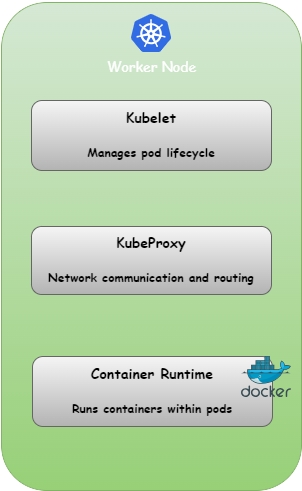Understanding Kubernetes: Part 2 -Worker Node

If you’ve been following our Kubernetes series 2025, welcome back! For new readers, check out Part 1: Understanding Kubernetes: Part 1 -Control Plan
Kubernetes Worker Node
A Worker Node is a machine in a Kubernetes cluster that runs the actual application workloads. It hosts the components necessary to execute and manage containers, ensuring that they meet the desired state defined by the control plane.
When a pod is scheduled on a worker node, it is the worker node’s responsibility to run the pod’s containers, monitor their performance, and manage networking and storage.
Key Components of a Worker Node:
Kubelet:
The primary node agent that communicates with the control plane.
Ensures that the containers described in the pod specification are running and healthy.
Continuously monitors the pod’s status and reports back to the control plane.
2. Container Runtime:
Responsible for pulling container images and running containers.
Examples include Docker, containerd, or CRI-O.
3. Kube Proxy:
Manages networking for the node, ensuring that services are reachable and load balancing is performed between pods.
Implements network rules to allow communication within the cluster.
4. Node Components (optional, but often present):
Tools for monitoring (e.g.,
cAdvisor).Logging agents (e.g., Fluentd).
Example:
In a scenario where a pod is scheduled on a worker node:
The Kubelet receives the pod specification from the control plane and ensures the required containers are running.
The Container Runtime pulls the necessary images and starts the containers.
The Kube Proxy sets up networking rules to allow communication between this pod and other pods or services in the cluster.
If the pod crashes, the Kubelet ensures it is restarted based on the pod’s restart policy.
Worker Node Responsibilities in Cluster Operations:
Hosting and running pods.
Managing pod networking.
Reporting status to the control plane.
Scaling workloads as directed by the control plane.
🚀 Ready to Master Kubernetes?
Take your Kubernetes journey to the next level with the Master Kubernetes: Zero to Hero course! 🌟 Whether you’re a beginner or aiming to sharpen your skills, this hands-on course covers:
✅ Kubernetes Basics — Grasp essential concepts like nodes, pods, and services. ✅ Advanced Scaling — Learn HPA, VPA, and resource optimization. ✅ Monitoring Tools — Master Prometheus, Grafana, and AlertManager. ✅ Real-World Scenarios — Build production-ready Kubernetes setups.
🎓 What You’ll Achieve
💡 Confidently deploy and manage Kubernetes clusters. 🛡️ Secure applications with ConfigMaps and Secrets. 📈 Optimize and monitor resources for peak performance.
🔥 Start Learning Now: [Join the Master Kubernetes Course](https://cloudops0.gumroad.com/l/k8s)
Don’t miss your chance to become a Kubernetes expert! 💻✨
🚀 Stay ahead in DevOps and SRE! 🔔 Subscribe now and never miss a beat on Kubernetes and more. 🌟
Last updated